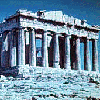





















| The Acropolis of Athens, a large rock
outcropping in the center of the city, was originally a citadel constructed
with a defensive wall around it. Legendary site of the struggle between
Athena, goddess of wisdom and military tactics, and Poseidon,
god of the sea, for the allegiance of the local inhabitants, the Acropolis
was also long in use as a sacred sanctum. At the start of the fifth century
B.C., a temple to Athena atop the Acropolis was destroyed during the invasion
of the Persians. It was rebuilt from 448 to 430 B.C. under the patronage
of the Athenian political leader Pericles and the aesthetic guidance of
the sculptor Phidias. Constructed entirely of marble, the Parthenon was
an outstanding example of a temple built according to the Doric
order. In its pediments were sculptures depicting the
birth of Athena and her struggle with Poseidon. On the metopes
between the triglyphs of the frieze were relief
sculptures of men battling centaurs and lapiths. Most controversial is the
continuous frieze that runs along the perimeter of the wall inside the peripteral
columns. Interpretation of the procession depicted there is still debated;
the greatest consensus centers on the interpretation that the girls, oxen,
water carriers, horsemen, chariots, and others are participating in the
Panathenaic Procession, a yearly ritual celebrating the birthday of Athena.
Other important buildings constructed on the Acropolis during the fifth century B.C. are the Propylaeum, the gateway to the plateau, the Temple of Athena Nike, a small Ionic temple, and the Erectheion, dedicated not only to Athena, but also to Poseidon and others Greek heroes. The Erechtheion, which has an Ionic portico, is best known for the Porch of the Caryatids, in which columns shaped like maidens carry the entablature on their heads. |
ACROPOLIS RESOURCES
|